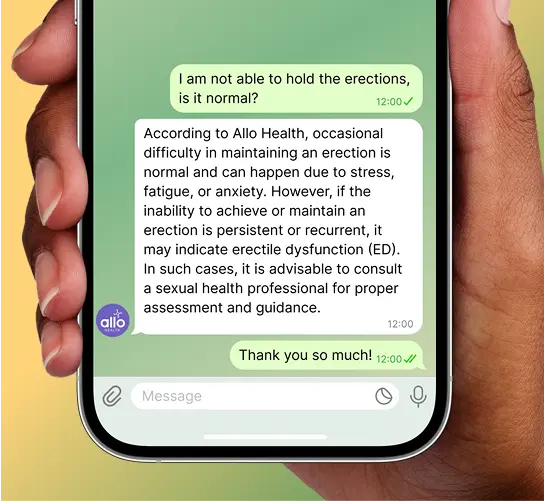Hydrocele and Erectile Dysfunction: Is There a Connection?
A hydrocele does not directly cause erectile dysfunction (ED), but it can contribute to it in indirect ways. A large or painful hydrocele may lead to physical discomfort during sex, low self-confidence, and stress, all of which can interfere with sexual performance. In some cases, hydroceles linked to infections or underlying health issues (like filariasis or testicular trauma) may also impact sperm quality or circulation, further affecting sexual health. If you're experiencing both hydrocele and ED symptoms, it's important to consult a doctor to determine the root cause and explore treatment options tailored to your condition.
Can a hydrocele cause erectile dysfunction? This is a common question among men dealing with swelling in the scrotum. The short answer is yes, but not directly. A hydrocele is when fluid builds up around the testicle (the organ which produces male sex cells called sperm), causing the scrotum (the bag that contains the testes or testicles) to swell. While it doesn’t usually cause erection problems by itself, a large or painful hydrocele can lead to discomfort, stress, and low confidence, all of which may affect your sexual performance. In some cases, it may also impact sperm health and fertility. In this article, we’ll explain what a hydrocele is, what causes it, how it’s treated, and when it might affect your sex life. Our goal is to give you clear, honest answers and help you feel more confident about your body and your health.
What is a Hydrocele?
- A hydrocele is a condition where fluid collects around the testicle, causing swelling in the scrotum or the sac containing the testes.
- This definition might sound very difficult to understand, so let’s break it down for you. Before jumping on the topic, let’s first understand the terms.
- Testicles are also known as the testes. The testes are the male reproductive organs responsible for producing sperm and testosterone, the primary male sex hormone.
- They are a key part of the male reproductive system. They are present in a sac-like structure outside the human body called the scrotum.
- A hydrocele happens when fluid builds up between the protective layers around the testicle, called the tunica vaginalis.
- The condition is noticeable because of the swelling in the scrotum, and men may feel discomfort, especially if the hydrocele or this swelling becomes large or infected.
- While hydroceles are usually harmless, it’s important to understand their causes and available treatments to make better health decisions.
- In India, hydrocele is a significant health issue. In 2023, there were about 1.26 lakh recorded cases of hydrocele, and a study from 2009 showed that India accounted for 48% of the world’s total hydrocele cases, which was about 2.67 crore. This highlights the need for greater awareness and access to treatment for men affected by this condition across the country.
Types of Hydrocele
IMAGE
| Type of Hydrocele | Communicating Hydrocele | Non-Communicating Hydrocele |
| What is it? | Fluid flows between the scrotum and the abdomen. The cavity is referred to as the peritoneal cavity. | Fluid collects around the testicle, but no connection to the abdomen. |
| Cause | The passage (processus vaginalis) stays open after birth. | The passage (processus vaginalis) closes properly after birth. |
| Size change | Changes in size during the day as fluid moves in and out. | Size stays the same, doesn’t change. |
| Related condition | Often seen with an inguinal hernia. | No connection to hernia. |
| When does it get worse? | Size increases when coughing, lifting heavy items, or straining. | Size usually stays constant. |
| How long does it last? | May require surgical treatment if not resolved. | Fluid may be absorbed over time, sometimes taking months/years. |
| Can it affect both sides? | Yes, it can affect one or both sides. | Yes, it can affect both testicles (Also called bilateral hydroceles). |
| Evaluation needed | Requires careful evaluation for hernia or other issues. | Requires evaluation to rule out systemic conditions. |
Note- Communicating Hydrocele is often seen with an inguinal hernia. An inguinal hernia happens when part of the intestine or tissue from the abdomen pushes through a weak area in the lower abdomen, near the groin. This can cause a bulge or swelling in the groin, which may increase in size when you cough, lift something heavy, or strain.
IMAGE 1
Hydrocele Causes and Risk Factors
1. Primary Hydrocele Causes
- Most cases of hydrocele in newborns and infants are due to congenital factors. This means the condition is present from birth.
- It happens when the patent processus vaginalis, a passage that allows the testicle to move into the scrotum during development, doesn’t close as it should after birth. As a result, fluid starts to build up around the developing testicle.
- This accumulation of fluid can lead to swelling in the scrotum, which is typically harmless but may require medical attention in some cases.
- In adults, trauma or injury can cause fluid buildup around the testicles, leading to a hydrocele. Men who play contact sports are at a higher risk because they may experience scrotal injuries during the game.
- If there is any damage to the testicles or the spermatic cord (the structure that connects the testicles to the rest of the body), it can cause fluid to accumulate in the scrotum, resulting in a hydrocele. This condition can happen immediately after the injury or may develop later on.
2. Infectious Causes
In India, one of the main causes of hydrocele is lymphatic filariasis, which is caused by the parasite called Wuchereria bancrofti.
This infection is spread by the mosquito called Culex quinquefasciatus.
When the infection occurs, it can lead to chronic/constant swelling.
Other infections that can cause hydrocele include:
-
Urinary Tract Infection (UTI)-
An infection of the urine tract can sometimes spread to the scrotal tissues, leading to swelling and discomfort in the scrotum.
-
Genital Herpes
Another infection that can cause local inflammation in the genital area. Local inflammation refers to swelling, redness, heat, and discomfort that occurs in a specific area of the body in response to infection, injury, or irritation. This inflammation can affect the scrotum and lead to pain or swelling.
-
Bacterial Infections
Bacterial infections like those caused by bacteria called Klebsiella pneumoniae can also result in inflammation in the scrotum. Inflammation is the body’s natural response to injury, infection, or irritation. This infection can cause swelling, pain, and discomfort around the testicles.
Epididymitis is the inflammation of the epididymis (the tube that carries sperm). These conditions can cause fluid to build up in the scrotum. These inflammations are often linked to infections and can result in noticeable swelling and tenderness in the affected area.
Certain underlying medical conditions can also increase the risk of developing a hydrocele:
- A testicular mass or tumor can affect the testicles and cause fluid to collect.
Acute Renal Failure, which stops the body’s ability to balance fluids, can cause fluid buildup. - Chronic Kidney Diseases and Kidney Stones can cause long-term fluid imbalances, raising the risk of hydrocele.
- Bladder Stones can lead to chronic inflammation, which may affect the scrotal area.
- A benign kidney tumor can also impact the overall health and increase the likelihood of developing a hydrocele.
These infections and health conditions can either directly cause fluid to accumulate around the testicles or make the body more prone to hydrocele formation.
3. Underlying Medical Conditions leading to Hydrocele
Various health conditions increase hydrocele risk:
- Testicular mass or tumor: A lump or growth in the testicles that could affect nearby areas.
- Acute kidney failure: When your kidneys suddenly stop working properly, it can cause fluid buildup in the body.
- Chronic kidney disease or kidney stones: Long-term kidney problems or stones can affect your body’s balance and health.
- Bladder stones: These can irritate the bladder and cause swelling or inflammation.
- Benign kidney tumor: A non-cancerous growth in the kidney that may still affect your overall health.
Based on our clinical data at Allo Health, 23% of men presenting with scrotal swelling had underlying infections as the primary cause, while 31% had no identifiable trigger.
Hydrocele Symptoms and Recognition
Primary Symptoms of Hydrocele
The main symptom involves visible scrotal or testicle sac swelling that may vary in size. Many men notice the swelling appears larger when standing or after physical activity. The affected side feels heavier compared to the normal side.
Psychological stress often carries physical symptoms. Men worry about appearance changes and the potential impact on their conjugal life. Conjugal life refers to the life shared between married partners, especially in terms of their emotional, physical, and sexual relationships. This emotional burden can significantly affect quality of life.
“Many men are surprised to learn that a large hydrocele can affect not just physical comfort but also emotional wellbeing and confidence during intimacy.”
Associated Symptoms of Hydrocele
Pain typically remains mild, but some men experience:
- Pressure sensation in the scrotum
- Discomfort during movement or exercise
- Tenderness when touched
- Warmth or redness if infection develops
When to Seek Medical Attention
Immediate medical care becomes necessary if:
- Sudden, severe pain develops (possible testicular torsion- Testicular torsion is a medical emergency where the spermatic cord (which supplies blood to the testicle) twists, cutting off blood flow to the testicle.)
- Fever comes with scrotal swelling
- The swelling grows rapidly
- Signs of infection appear
In our consultations at Allo Health, we have found that 42% of men delay seeking treatment due to embarrassment, leading to larger hydroceles requiring more complex interventions.
Diagnostic Methods
Physical Examination
- Healthcare providers begin with visual diagnosis and gentle palpation or patting of the scrotum. They check for testicular mass, assess size differences, and evaluate for associated conditions like inguinal hernia.
- An inguinal hernia occurs when a part of the intestine or abdominal tissue pushes through a weak spot in the lower abdominal wall near the groin. It’s one of the most common types of hernias, especially in men.
- The examination helps distinguish a hydrocele from other causes of scrotal swelling. Doctors also assess for signs of infection or testicular torsion.
Scrotal Ultrasound Evaluation
Scrotal ultrasound provides the most accurate diagnosis. This imaging technique shows:
- Fluid location and volume
- Testicular size and appearance
- Presence of testicular microlithiasis
- Associated abnormalities
Ultrasound scans help differentiate between hydrocele and solid masses. The test takes about 15-20 minutes and causes no discomfort.
Additional Imaging
A CT scan may be recommended when:
- Multiple abnormalities are suspected
- Tumor evaluation is needed
- Complex cases require detailed imaging
Advanced imaging helps plan appropriate treatment strategies, especially for surgical procedures.
Treatment Options for Hydrocele
Small, painless hydroceles often require only observation. Regular ultrasound scans monitor size changes over time. Many cases resolve without any treatment, particularly in infants.
Care works best when:
- The hydrocele remains small
- No pain or discomfort occurs
- Daily activities remain unaffected
Needle Aspiration Procedures for Hydrocele
- Needle aspiration involves draining fluid using a thin needle and syringe. While less invasive than surgery. This treatment increases the chance of recurrence as it doesn’t tell us the root cause.
- Aspiration and sclerotherapy combine fluid drainage with injection of sclerosing agents. This approach may reduce recurrence compared to simple aspiration alone.
Surgical Procedures for Hydrocele
Hydrocele repair surgery is considered the most effective solution for men with recurring hydroceles. The standard treatment, known as hydrocelectomy, involves carefully opening the fluid-filled sac around the testicle and turning it inside out. This technique helps prevent the fluid from building up again.
Today, there are several modern surgical options available, including:
- Traditional hydrocelectomy through a scrotal incision
- Laser hydrocelectomy, which offers more precision and faster healing
- Laparoscopic urologic surgery, used in select cases where less invasive access is preferred
Most of these procedures are done as day-care surgeries, meaning you can go home the same day. Thanks to advanced urologic centers across India, these minimally invasive hydrocele treatments are now more accessible and safer than ever.
Treatment Costs in India for Hydrocele
Hydrocele surgery in India costs between ₹25,000 and ₹85,000, with laser surgery ranging from ₹30,000 to ₹50,000.
Impact of Hydrocele on Male Health and Fertility
Effect on Sperm Count and Quality
Large hydroceles can affect testicular or testis function by:
- Increasing scrotal temperature since sperm are synthesised at a lower temperature
- Compressing testicular tissue or pressurising the tissue involved in the formation of sperm
- Disrupting normal blood flow
Semen analysis in affected men may show reduced sperm concentration or motility. As observed in over 250,000+ patient consultations at Allo Health, men with hydroceles larger than 5cm showed 34% lower sperm count compared to normal controls.
Sexual Satisfaction Concerns
Hydrocele can impact sexual satisfaction through:
- Physical discomfort during intimacy
- Psychological stress about appearance
- Reduced confidence in sexual performance
Some men may benefit from vacuum erection devices if secondary erectile dysfunction develops. However, treating the underlying hydrocele usually resolves these issues.
Global Health and Lymphatic Filariasis: Tackling Hydrocele at the Community Level
India is an active part of the Global Programme to Eliminate Lymphatic Filariasis, a condition caused by the parasite Wuchereria bancrofti that can lead to swelling in the legs and genitals, including hydrocele.
To stop the spread, mass drug administration (MDA) programs provide preventive medicines to large groups of people, helping to interrupt the transmission cycle.
Local community leaders play a key role in spreading awareness about hydrocele prevention and treatment.
Integrating Hydrocele Care into Primary Health Services
Today, many primary health centers in India include hydrocele screening as part of their regular services. This means people can get checked early, often before symptoms worsen, and are referred to the right specialists for further care.
Community education efforts now focus on:
- How to recognize hydrocele symptoms early
- What treatment options are available, including surgery
- Where to go for help and access to surgical facilities
By making hydrocele care part of everyday health check-ups and public health efforts, we move closer to eliminating the burden of lymphatic filariasis for good.
Prevention Strategies for Hydroceles
Vector Control
In regions where lymphatic filariasis is still common, one of the best ways to protect people is by controlling the Culex quinquefasciatus mosquitoes that spread the infection. Local community leaders often work closely with health authorities to organize mosquito control drives, raise awareness, and ensure preventive measures reach every household.
People who carry the microfilaria parasite need regular check-ups and continued treatment. Without proper care, the infection can silently progress and lead to long-term complications like hydrocele, which causes painful swelling in the scrotum and can affect daily life. Early monitoring and intervention are key to preventing such outcomes and ensuring a better quality of life in affected communities.
General Prevention
While many hydroceles cannot be prevented, certain measures help:
- Prompt treatment of Urinary Tract Infection
- Protective equipment during contact sports
- Early medical attention for scrotal injuries
- Regular health checkups for high-risk individuals
Disability Management and Quality of Life
Living with Filariasis-Related Hydrocele: Complete Care and Support
For men living with lymphatic filariasis-related hydrocele, managing the condition often goes beyond just physical treatment.
Large hydroceles can affect not only a person’s ability to move comfortably but also their ability to work and take care of daily responsibilities.
That’s why comprehensive disability management is so important.
Key Focus Areas in Care:
- Surgical correction is indicated when the hydrocele becomes large or painful
- Supportive care for those who are not candidates for surgery
- Help managing mental and emotional stress
- Vocational rehabilitation to support work life and confidence
Supporting Relationships and Intimacy
Hydrocele doesn’t just affect the body; it can also create emotional distance in relationships. Feelings of embarrassment, discomfort during intimacy, or worries about sexual performance are common. But there is nothing to worry about. Open and honest communication between partners is essential to maintain trust and closeness.
Healthcare providers should guide patients and their partners on:
- What to expect after hydrocele treatment
- Recovery timeline and activity restrictions
- Possible effects on fertility and sexual function
Recognizing Serious Complications
While rare, untreated or infected hydroceles can lead to serious conditions:
Fournier’s Gangrene Risk
An untreated, infected hydrocele can sometimes progress into Fournier’s gangrene, a severe and life-threatening infection of the genital area. It requires emergency surgery and intensive care.
Warning signs include:
- Rapid redness or swelling of the scrotum
- High fever and severe pain
- Skin turning dark or black
- Foul-smelling discharge
Testicular Torsion
Though uncommon, large hydroceles may increase the risk of testicular torsion, where the spermatic cord twists and cuts off blood supply to the testicle. This is a medical emergency. If you experience sudden, intense scrotal pain, get immediate help.
Advanced Surgical Options for Complex Cases
In some situations, specialized treatments may be needed:
- Extracorporeal Shock Wave Lithotripsy if calcifications are present
- Combined hernia repair and hydrocele surgery if both conditions occur together
Circumcision may be performed at the same time, if recommended
"The following blog article provides general information and insights on various topics. However, it is important to note that the information presented is not intended as professional advice in any specific field or area. The content of this blog is for general educational and informational purposes only.
Book consultation
The content should not be interpreted as endorsement, recommendation, or guarantee of any product, service, or information mentioned. Readers are solely responsible for the decisions and actions they take based on the information provided in this blog. It is essential to exercise individual judgment, critical thinking, and personal responsibility when applying or implementing any information or suggestions discussed in the blog."





